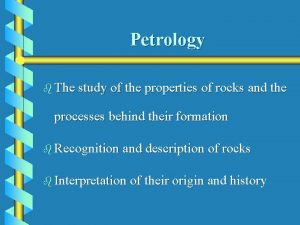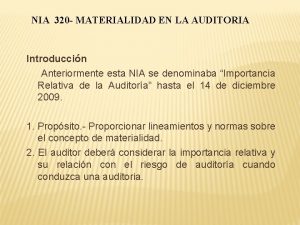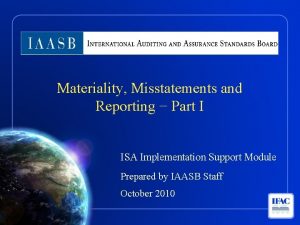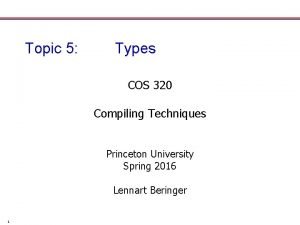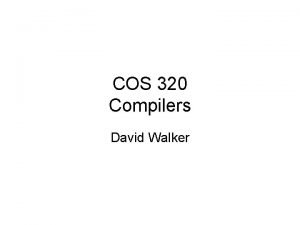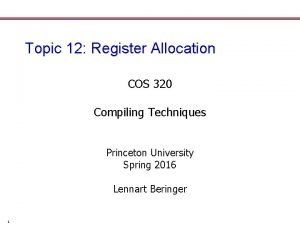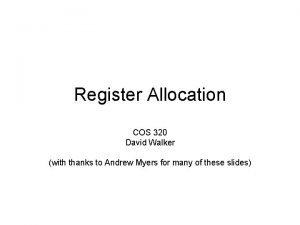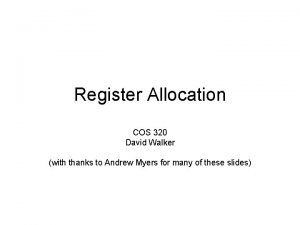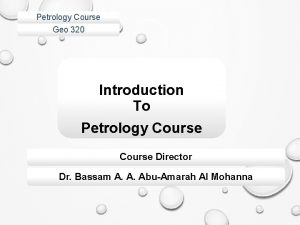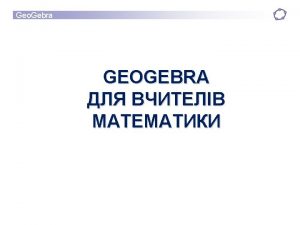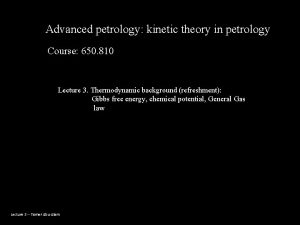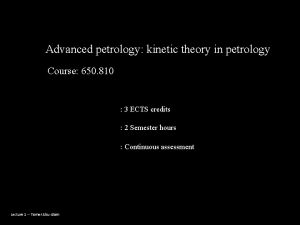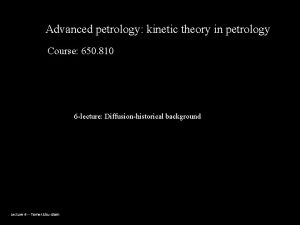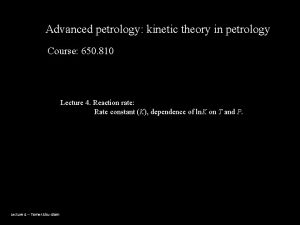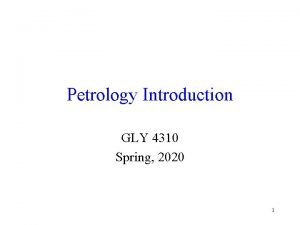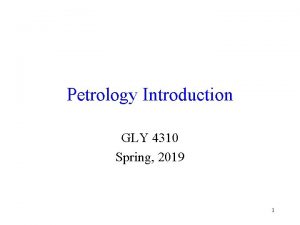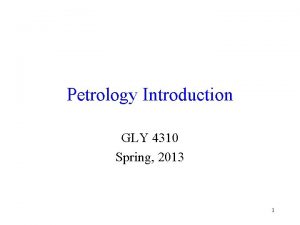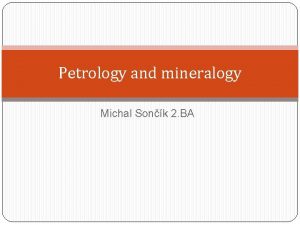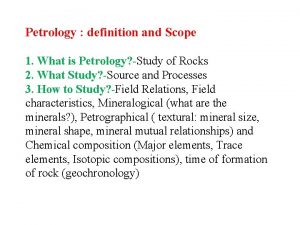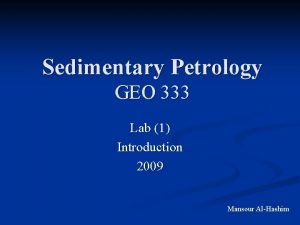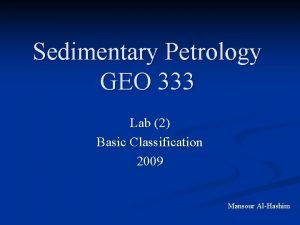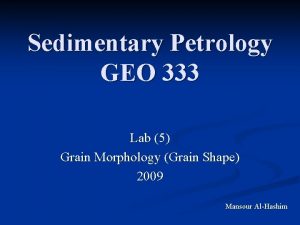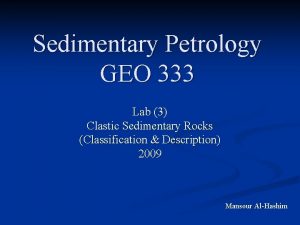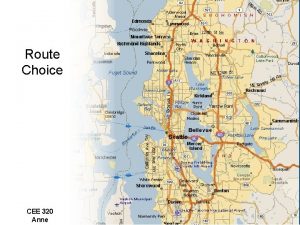Petrology Course Geo 320 Introduction To Petrology Course




























- Slides: 28

Petrology Course Geo 320 Introduction To Petrology Course Director Dr. Bassam A. A. Abu-Amarah Al Mohanna

I. Introduction • Petrology Definition, üPetrology: (Is a Greek word means : “Petra means “rock” and ü“Logos” mean“knowledge”). So, Ø It is a Rocks’ study to identify their: 1) occurrences, 2) 2 composition, 3)origin and 4) evolution.

So, ØPetrological description : § Comprises rock ‘s occurrence, attitude, structure, mineralogy, chemical composition, to know its origin (Petrogenesis) of rock’s unit diversities, Furthermor e, • PETROLOGY : focuses primarily on the rock formation, or Rock’s Petrogenesis (Origin), while, • Petrography is (Microscopic rock’s study) deals with the 3 detailed description and classification of rocks via its mineral’s composition,

So, The Petrologists (Persons who study rocks) tasks are : 1. To carry out study on rocks which are forming parts of the lithosphere that are clearly different from their surroundings rocks, and 2. To draws conclusive (Definite) records about Evolution and Constitution of the Earth on the crust and deep init. Ø It is primarily based on volcanic eruptions, shape and composition of igneous bodies that have extended to the Earth’s surface by tectonic processes and erosion. 4 Therefore;

So, the most major Petrological processes is to focus on the following: 1. Tectonic movements of rock masses. 2. Magmas generation and its injection into the lithosphere and crust, in addition Volcanic eruptions. 3. Physical, chemical and biological weathering, and depositional processes in the earth’s surface , in the hydrosphere, and in the atmosphere. 4. Mutual chemical reactions and biological processes in aqueous solutions. 5

5. Metamorphic changes due to increasing pressure and temperature at greater depths of covering. 6. Melting, migration, recrystallization, degassing and similar events take place on rocks. Hence, 1. In general; all Rocks types , are composed of certain minerals (minerals aggregates Components= Rock), So, Petrology mineralogy. is closely associated with the 6

Ø In addition; “Petrology is the study of the rocks involve their chemical composition (mineral chemistry and geochemistry) through studying the complex chemical reactions and their formation processes Ø So, determination of rock’s : 1. mineral constituents and 2. chemical composition necessary to study and to distinguish among Are the rocks occurrane, and also for resolving the 7 origin of them.

As a result, Why Petrology is very important in Geophysics studies and explorations? because 1. The Petrology is also illustrating rock’s physical proparities, which are varies from one rock to another (On/within the crust and lithosphere) of the earth, and 2. It has an important role in geophysical explorations for discriminating and discovering different rocks types, 8 3. As well as, their potential resources encountered.

II. Structure of The Earth: Ø The Earth is an oblate spheroid in shape. Ø It is composed of a number of different zones in elliptical shells shape as determined by deep seismic evidence, Ø These layers are : I. Crust Zone : The outer most solid silicate crust, surrounding the earth. 1) It is rigid and solid rocks layer. It is composed of granitic-rich continental crust. 9

2) The Oceanic crust is thin zone, varies in thickness from 4 to about 12 km. • It is also composed of basalt and has a density of about 3 gr/cm 3. • The Continental crust thickness varies between 40 and 70 km and composed mainly of lighter granites, pegmatites and gneisses. • The density of continental crust is about 2. 7 gr/cm 3. 10

II. The Mantle comprises 83% of the earth volume: the top mantle zone called Lithosphere, solid and rigid. Ø The crust and the top of solid mantle (Lithosphere) floats on the “Asthenosphere (middle mantle) as a components of a plate. 11

• The mantle comprises Lithosphere, Asthenosphere and Mesosphere zone. • The mantle zone is surrounding the core zone, with a thickness of 2900 km. • The upper mantle (Lithosphere) exists from the base of the crust down- ward to a depth of about 400 km. 12

• This region Lithosphere) of the Earth’s interior is composed of peridotite, an ultramafic rock made up of the minerals olivine and pyroxene. • The middle mantle zone called (Asthenosphere) lies between 400 to 1000 km below earth surface. 13

Ø This layer has a physical properties differ from the upper mantle (lithosphere). Ø It is hot and plastic, the higher pressure causes formation of minerals differ from of the upper mantle. 14

Ø The CRUST thickness and the upper mantle (Lithosphere) is about 400 km thick, Ø and it has the ability to glide (Slide) over the rest of the middle mantle (Asthenosphere) and flow due to the increase in 1. Pressure, and 2. Temperature. 15

III. The core zone : it is involved of: 1) Inner core solid, rich in Fe (Iron) and Ni (Nickel), with a density of about 10. 3 g/cm 3. Its radius of about 1220 km. 2) Outer Core (OC) is a liquid with a density of about 6 g/cm 3. • OC surrounds the inner core and with thickness of about 2250 km. 16

Both 1) crust and 2) upper mantle (lithosphere) zones are forming a numerous tectonic plates that float on top of the middle mantle (Asthenosphere). These plates move slowly due to the convection currents within the mantle across the asthenosphere causing PLATE TECTONIC. The tectonic plates have the ability to rise and to sink, known as isostasy natural Phynomenon, Because the crust floats on top of the mantle-like ice cubes in water. 17

Earth’s Zones Structures’ Discontinuity v The Earth’s Zoned structures separated by imaginary separation line called Discontinuity due to the differences in Rocks’ composition is reflecting their physical characteristics: 1. The imaginary line separates between the Earth’s (Continental & Oceanic) crust and the upper mantle is called : . • ( MOHO) discontinuity , named after Andrija Mohorovicic, a Croatian Geophysicist. ü It lies deep in about 5 to 10 km (3 -6 miles) below the ocean floor and ü About 20 to 90 km (10 - 60 miles) deep beneath the 18

2. The imaginary separation linwe between the solid lower mantle (Mezosphere) and the molten outer core is called • The Gutenberg discontinuity, named after German scientist Bruno Gutenberg, ü It is located at 2900 km depth beneath the Earth’s surface. ü It is determined by applying Seismic waves. 19

For that reason, At any dynamic change in Isostasy, the plates collide or move causing Earthquakes, Tsunami and related natural hazards and disasters. Thus, The PETROLOGY (rocks’ Studies) applied in/within the crusts and upper mantle Rocks. 20

III. ROCKS’ CLASSIFICATION The rocks of Earth’s crust and upper mantle are divided into three main groups according to their origin, as follow: 1. Igneous Rocks § Igneous came from “ignis” means “fire” in Latin and eruptive). These rocks are a primary rocks. § Igneous Rocks occurred and formed in/on the Earth 21 via two manner either by:

1. Inside (down in the earth); • formed by a direct slow cooling rate, crystallized, and solidified from a molten A light-color fine to medium rock mass (called magma). OR 2. Outside in the earth’s surface; grained igneous rock (granite) containing interlocking minerals of quartz (white) and feldspar (light rosy or pink) with minor grains (black) of hornblende, biotite and chlorite. 22

§ Volcanic rocks Formed via fast cooling rate (surface of the earth) fine Crystallized grains from LAVA formed on the earth’s surface we call it “lava”; ( i. e. when magma reaches to the earth’s surface or at a very shallower depth). 23

2. Sedimentary Rocks: Sedimentary (depositional) rocks, formed and deposited in the sea, infresh water or on land or by precipitation, and sedimentation processes; via the following: 1. Solid material of physical and chemical weathering of rocks formed earlier. 2. Organogenic or fossil remains and other biochemical and chemical products extracted from the seawater. 24

Classification of Sedimentary Rocks u. There are three Classes of Sedimentary Rocks: 1. ) Detrital sedimentary rocks èMechanical rock weathering byproducts are transported to new location, cement together 2. ) Chemical sedimentary rocks èSoluble material, dissolved by chemical weathering, precipitates by organic or inorganic processes 3. ) Biochemical sedimentary rocks èThese rocks form as a result of once living organisms accumulating to form solid rock.

26

3. Metamorphic Rocks: § The metamorphic rock is a transformation status of a pre-existing rock (Original rock of igneous, metamorphic, and sedimentary) subjected to : 1. a very high heat (increases Temperature from 150 to 200 o C, and 2. Pressure increased to an about +1500 bar located at a greater depth , ü Causing changes in their physical and/or chemical in rock’s minerals crystal form (texture and structure) in solid 27 state due to active fluid and contact with magma.

28
 Petrology is the study of
Petrology is the study of Pms 320 navy
Pms 320 navy Notifier 320 manual
Notifier 320 manual Nia 320
Nia 320 I isa
I isa Miaa-320
Miaa-320 Dynamixel xl
Dynamixel xl Cos 320
Cos 320 The new futura 320 laser printer
The new futura 320 laser printer The new futura 320 laser printer
The new futura 320 laser printer Cyranose 320 ebay
Cyranose 320 ebay Simplify radicals calculator
Simplify radicals calculator How many sig figs in 320
How many sig figs in 320 Tms 320
Tms 320 Agreement of purchase and sale form 100
Agreement of purchase and sale form 100 Cmpt 320
Cmpt 320 Aae 320
Aae 320 Ubc cpsc 320
Ubc cpsc 320 Cosc 320
Cosc 320 Cos 320°
Cos 320° 320 strategy
320 strategy Ytmp 320
Ytmp 320 Aae 320 uw madison
Aae 320 uw madison Input process output
Input process output Cos 320 degrees
Cos 320 degrees Ucas old tariff
Ucas old tariff Cos 320°
Cos 320° Cos 320
Cos 320 Aae 320
Aae 320
